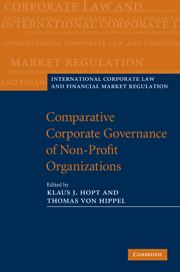Book contents
- Frontmatter
- Contents
- List of contributors
- Preface
- Abbreviations
- PART I Economic findings and theories on nonprofit organizations
- PART II The nonprofit sector: private law, trust law, tax law in selected countries
- 4 Anglo-American countries
- 5 Germanic countries
- 5.1 Nonprofit organizations in Germany
- 5.2 Nonprofit organizations in the Netherlands
- 6 Romanic countries
- 7 Transformation countries
- PART III The board of nonprofit organizations
- PART IV Good governance of nonprofit organizations: activities and regulatory problems
- PART V Good governance of nonprofit organizations: self-regulation, disclosure and supervision
- Index
- References
5.2 - Nonprofit organizations in the Netherlands
from 5 - Germanic countries
Published online by Cambridge University Press: 05 August 2011
- Frontmatter
- Contents
- List of contributors
- Preface
- Abbreviations
- PART I Economic findings and theories on nonprofit organizations
- PART II The nonprofit sector: private law, trust law, tax law in selected countries
- 4 Anglo-American countries
- 5 Germanic countries
- 5.1 Nonprofit organizations in Germany
- 5.2 Nonprofit organizations in the Netherlands
- 6 Romanic countries
- 7 Transformation countries
- PART III The board of nonprofit organizations
- PART IV Good governance of nonprofit organizations: activities and regulatory problems
- PART V Good governance of nonprofit organizations: self-regulation, disclosure and supervision
- Index
- References
Summary
Introduction
The term “nonprofit organizations”
In the Netherlands, the term “nonprofit organizations” does not have a legally specific meaning. The term is often used unofficially for organizations that have a purpose other than profit making, and for organizations that are forbidden to distribute their profit to their members. In organizational (civil) law, the term nonprofit organization as such is not used, but the legal definitions of the available organizational forms – the vereniging (association) and the stichting (foundation) – express their nonprofit character (see II A and B). In tax law, a special category of verenigingen (associations) and stichtingen (foundations) is formed by the public benefit organizations; in contrast to other nonprofit organizations, they receive tax benefits (see III).
The non-distribution constraint is certainly an element of the definition of nonprofit organizations in the Netherlands. It applies certainly to foundations; according to regulatory law, at the liquidation of an association the surplus should be distributed to the members unless the articles of association provide otherwise. In associations with a public benefit, the articles of association normally provide otherwise. The legal rule about the distribution of the liquidation surplus to the members is in fact only legitimized for common interest associations, where the members have financed the activities of the association.
From a civil law perspective, one can categorize these into membership organizations (associations) and non-membership organizations (foundations). From a tax law perspective, one can categorize these into public interest organizations and non-public interest organizations.
- Type
- Chapter
- Information
- Comparative Corporate Governance of Non-Profit Organizations , pp. 228 - 264Publisher: Cambridge University PressPrint publication year: 2010
References
- 1
- Cited by



